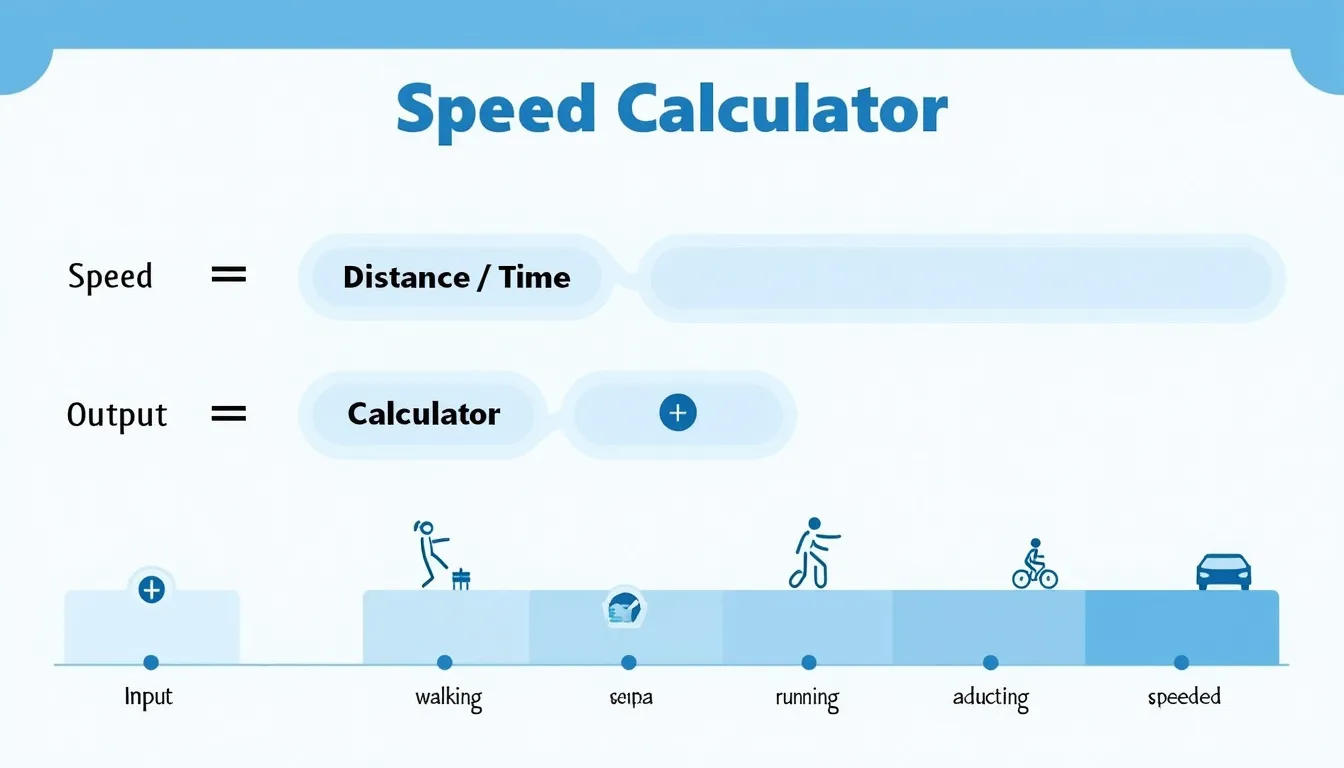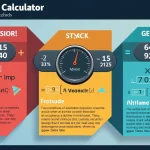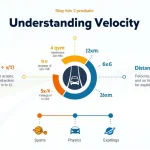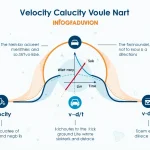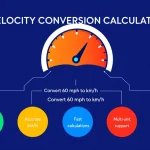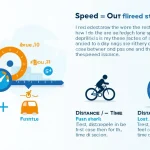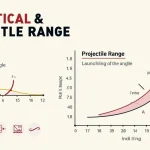Speed Calculator
Is this tool helpful?
Speed Calculator: Quickly Determine Velocity with Precision
Welcome to our comprehensive guide on the Speed Calculator, a powerful tool designed to help you accurately calculate velocity based on distance and time inputs. Whether you’re a student studying physics, an engineer working on motion-related projects, or simply curious about the speed of various objects, this calculator is an invaluable resource for quick and precise calculations.
How to Use the Speed Calculator Effectively
Using our Speed Calculator is straightforward and intuitive. Follow these simple steps to get accurate results:
- Enter the distance traveled in meters in the “Distance (meters)” field.
- Input the time taken in seconds in the “Time (seconds)” field.
- Click the “Calculate Speed” button.
- The calculator will instantly display the speed in meters per second (m/s).
It’s important to note that both distance and time must be positive numbers. If you enter invalid values, the calculator will prompt you to enter valid positive numbers for accurate results.
Understanding Speed: Definition and Importance
Speed is a fundamental concept in physics and everyday life, representing the rate at which an object covers a certain distance over time. It is a scalar quantity, meaning it has magnitude but no direction. The standard unit for speed in the International System of Units (SI) is meters per second (m/s).
The mathematical formula for calculating speed is:
$$ Speed = \frac{Distance}{Time} $$Where:
- Speed is measured in meters per second (m/s)
- Distance is measured in meters (m)
- Time is measured in seconds (s)
Understanding and calculating speed is crucial in various fields, including physics, engineering, sports, transportation, and everyday activities. It helps us analyze motion, plan journeys, design vehicles, and make informed decisions about movement and travel.
Benefits of Using the Speed Calculator
Our Speed Calculator offers numerous advantages for users across different domains:
- Accuracy: The calculator provides precise results, eliminating human error in manual calculations.
- Time-saving: Instantly compute speed without the need for lengthy manual calculations.
- Versatility: Suitable for various applications, from academic studies to professional projects.
- User-friendly interface: Easy-to-use design makes speed calculations accessible to everyone.
- Educational tool: Helps students understand the relationship between distance, time, and speed.
- Real-world applications: Useful for planning trips, analyzing sports performance, and more.
Addressing User Needs and Solving Problems
The Speed Calculator addresses several common challenges and user needs:
1. Quick Problem-Solving
In academic settings, students often encounter speed-related problems in physics or mathematics courses. Our calculator allows for rapid problem-solving, enabling students to check their work or quickly arrive at solutions during time-sensitive exams or homework sessions.
2. Professional Applications
Engineers and scientists working on projects involving motion can use this tool to quickly verify calculations or estimate speeds for various scenarios. This efficiency can lead to faster project completion and more accurate results.
3. Sports and Fitness Analysis
Athletes and coaches can utilize the Speed Calculator to analyze performance in sports like running, cycling, or swimming. By inputting race distances and times, they can calculate average speeds and track improvements over time.
4. Travel Planning
Travelers can use this tool to estimate travel times for various modes of transportation. By entering the distance to their destination and the average speed of their chosen method of travel, they can plan their journeys more effectively.
5. Educational Support
Teachers and tutors can employ the Speed Calculator as a teaching aid to demonstrate the relationship between distance, time, and speed. It provides a hands-on way for students to explore these concepts and verify their manual calculations.
Practical Applications and Examples
Let’s explore some real-world examples to illustrate the practical applications of our Speed Calculator:
Example 1: Running Performance
A runner completes a 5000-meter race in 18 minutes and 30 seconds. To calculate their average speed:
- Convert time to seconds: 18 minutes 30 seconds = 1110 seconds
- Enter distance: 5000 meters
- Enter time: 1110 seconds
- Calculate: 5000 / 1110 ≈ 4.505 m/s
The runner’s average speed is approximately 4.505 m/s or 16.22 km/h.
Example 2: Vehicle Speed Limit Compliance
A car travels 2 kilometers in 90 seconds. To check if it’s within the 80 km/h speed limit:
- Enter distance: 2000 meters
- Enter time: 90 seconds
- Calculate: 2000 / 90 ≈ 22.222 m/s
Convert to km/h: 22.222 m/s * 3.6 ≈ 80 km/h. The car is traveling at the speed limit.
Example 3: Cycling Workout Analysis
A cyclist covers 30 kilometers in 1 hour and 15 minutes during a training session. To calculate average speed:
- Convert distance to meters: 30 km = 30,000 meters
- Convert time to seconds: 1 hour 15 minutes = 4500 seconds
- Enter distance: 30,000 meters
- Enter time: 4500 seconds
- Calculate: 30,000 / 4500 ≈ 6.667 m/s
The cyclist’s average speed is approximately 6.667 m/s or 24 km/h.
Example 4: Sound Travel Time
To calculate how long it takes for sound to travel 1 kilometer in air (speed of sound ≈ 343 m/s):
- Enter distance: 1000 meters
- Enter speed: 343 m/s
- Calculate time: 1000 / 343 ≈ 2.915 seconds
It takes approximately 2.915 seconds for sound to travel 1 kilometer in air.
Frequently Asked Questions (FAQ)
1. What units does the Speed Calculator use?
Our Speed Calculator uses meters (m) for distance and seconds (s) for time, providing results in meters per second (m/s).
2. Can I use this calculator for other units of speed?
While the calculator provides results in m/s, you can easily convert to other units. For example, to convert m/s to km/h, multiply the result by 3.6.
3. Why is my result showing as “undefined”?
This may occur if you enter zero for the time value. Speed cannot be calculated with zero time, as it would result in division by zero.
4. How accurate is the Speed Calculator?
Our calculator provides results to three decimal places, offering a high degree of accuracy for most practical applications.
5. Can I use negative values for distance or time?
No, the calculator requires positive values for both distance and time to provide meaningful results.
6. Is there a maximum limit for distance or time inputs?
The calculator can handle very large numbers, but extremely large values may affect the display of results. For practical purposes, there’s no upper limit that would be encountered in typical use cases.
7. How does this calculator handle very small speeds?
The calculator can handle very small speeds and will display the result to three decimal places. For extremely slow speeds, scientific notation may be more appropriate.
8. Can this calculator be used for calculating the speed of light?
While technically possible, the speed of light (approximately 299,792,458 m/s) is beyond the typical use case of this calculator. For such high speeds, specialized scientific calculators are more appropriate.
9. How does this calculator round the results?
The calculator rounds the results to three decimal places using standard rounding rules.
10. Is this calculator suitable for relativistic speed calculations?
No, this calculator is designed for classical mechanics and does not account for relativistic effects. For speeds approaching the speed of light, relativistic calculations are necessary.
Please note that while we strive for accuracy, we cannot guarantee that the webtool or results from our webtool are always correct, complete, or reliable. Our content and tools might have mistakes, biases, or inconsistencies.
Conclusion: Harness the Power of Precise Speed Calculations
Our Speed Calculator is an indispensable tool for anyone needing to quickly and accurately determine velocity based on distance and time. From students tackling physics problems to athletes analyzing their performance, this calculator offers a user-friendly solution for a wide range of applications.
Key benefits of using our Speed Calculator include:
- Instant, accurate results
- Time-saving efficiency
- Versatility across various fields
- Educational value for understanding speed concepts
- Practical applications in sports, travel, and professional settings
By providing a simple yet powerful interface for speed calculations, we aim to make this fundamental physics concept accessible and useful for everyone. Whether you’re a student, professional, or curious individual, our Speed Calculator is here to support your needs and enhance your understanding of motion and velocity.
We encourage you to explore the capabilities of our Speed Calculator and discover how it can benefit your studies, work, or personal projects. Start using it today to experience the convenience and accuracy it offers in your speed-related calculations!
Ready to calculate speed with precision? Try our Speed Calculator now and unlock the power of quick and accurate velocity measurements!
Important Disclaimer
The calculations, results, and content provided by our tools are not guaranteed to be accurate, complete, or reliable. Users are responsible for verifying and interpreting the results. Our content and tools may contain errors, biases, or inconsistencies. We reserve the right to save inputs and outputs from our tools for the purposes of error debugging, bias identification, and performance improvement. External companies providing AI models used in our tools may also save and process data in accordance with their own policies. By using our tools, you consent to this data collection and processing. We reserve the right to limit the usage of our tools based on current usability factors. By using our tools, you acknowledge that you have read, understood, and agreed to this disclaimer. You accept the inherent risks and limitations associated with the use of our tools and services.
